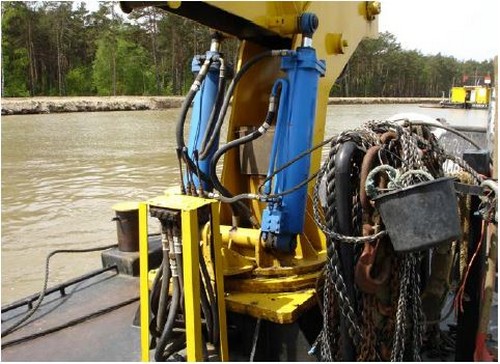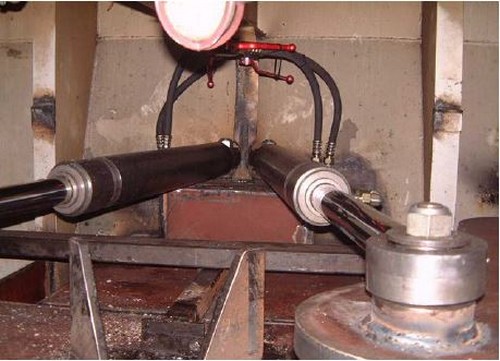Abschnitt 6.5 - 6.5 Working on water vehicles
6.5.1 General
Diverse hydraulic equipment is operated on water vehicles. There is a distinction between hydraulic systems required for traction drive of a vessel, e. g.
rudder system,
wheel house lift,
maneuvering aids such as bow thrusters, articulation devices or the like,
as well as
winches
and the machines installed on vessels and swimming devices (pontoon) for the most different applications, e. g.
dredgers,
rams,
cranes (see figure 42),
pump drives especially on tank vessels,
mobile hydraulic systems, as well as ramps, flaps, and bulkhead closing devices.
Due to the high forces required for the driving operation parts and superstructures to be moved on the vessels, the hydraulic equipment often is characterized by high dead loads. However, further particularities as described in sections 6.5.2 to 6.5.5 have to be observed additionally.

Fig. 42
Shipboard crane on a pusher vessel
6.5.2 Position change of the vessel
Floating vessels never stop moving. Due to pull and wave effects of passing vessels, wind and swell (even in coastal waters), even vessels positioned in ports are subject to slight lateral tilting movements by several angular degrees. Loading and unloading freight vessels result in a constantly changing floating position around the longitudinal and transverse axes.
The vessel movements can lead to unintended movements of unsecured vessel and machine parts. Thus, anticipatory planning of maintenance works on vessels is required.
 | Note |
|---|---|
| All works have to be coordinated with the shipmaster. | |
6.5.3 Unsecured hydraulic drives on vessels
For hydraulic systems for driving operation, e. g. rudder systems, high requirements are posed regarding the availability and the operational safety of the systems. Within the sphere of action of these systems driving operation, safeguarding measures resulting in the rudder system being deactivated automatically are inadmissible from the point of view of traffic law (see figure 43). Technical protective measures such as guards cannot be implemented in all positions. This poses the risk of accessing work and traffic areas, in which hydraulic parts are installed in an unprotected manner and stripping protections and pipe and hose rupture protections are frequently missing. Due to the confined installation situation and possible stumble positions, there is a high risk of pinching and thus direct danger to life due to moving system parts.

Fig. 43
Risks of pinching on a rudder system
6.5.4 Limited installation conditions
On the basis of the narrow installation situation in the hull and the metallic parts, interior walls, bulkheads, and doors on all sides, most of the maintenance work is "work in confined spaces", which is subject to special requirements regarding the electric equipment.
6.5.5 Redundancy of important drive operation systems
On the basis of vessel safety provisions, rudder systems are designed redundantly, i.e. in double design, in order to provide for high reliability and availability. This is to maintain the maneuverability even if the system has failed.
In doing so, different principles are applied:
two parallel identical systems supplied by different energy sources with automatic switch-over,
separately engaged emergency systems with limited continuous operation of the rudder system (emergency manual rudder, electric auxiliary pump),
accumulators allowing for a limited number of rudder movements.
Work on these systems must only be carried out after consultation with the shipmaster! Before starting any work on the hydraulic system, all relevant energy sources have to be turned off (see section 1.5). Even manual hydraulic rudder systems on small vessels and emergency manual pumps have to be secured against being used before starting any maintenance work.
